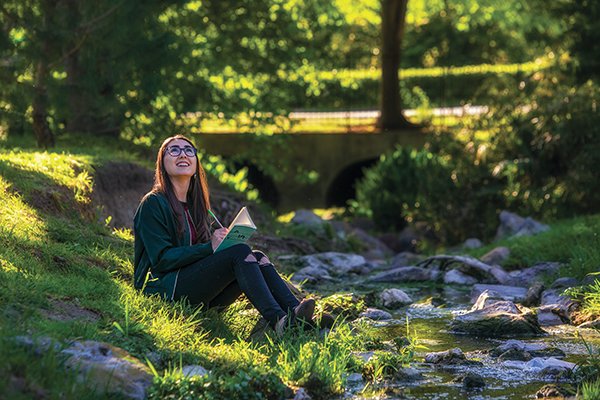Zoo out there
The main campus is full of life, in more shapes than we knew. One recent graduate uses her spare time to document it.
The tour begins at my guide’s favorite bench, by the spine facing the creek that runs through campus. During her time at Cal Lutheran, Emily Chebul ’17 sat there three or four days a week “for anywhere from half an hour to upwards of two hours” to watch animals, mostly birds.
“That’s an American robin, just hopping around,” she says, trying to wake me to the surroundings. “Let’s see, there’s a black phoebe that’s flying in between that little electrical unit. There’s another robin in the creek….”
“That’s an Allen’s hummingbird. They’re more orange-tinted than the Anna’s, which are more green.”
I see most of this. We walk upstream toward the Centrum Café and she points out a mallard which, otherwise, I’d have taken for a rock – “right there” in the shadows, with “one eye opening and closing.”
Anyone with peripheral vision can take up Chebul's hobby, anywhere on Earth. While earning a degree in environmental science, she added the campus boundaries to the collaborative citizen science platform iNaturalist. She has posted observations of mice, moths, beetles and bees from around Los Angeles, including near her volunteer job at the La Brea Tar Pits.
This map will help if you’re getting started. If headed toward the campus's edges, especially the hills above Olsen Road, be aware of ticks and know what a rattlesnake looks like. Download apps to help narrow down birds and other species by shape.
Chebul taught herself to spot living things while catching snakes and lizards in Santa Clarita from age 5 or 6.
“Everything’s in a pattern, and whatever breaks the pattern is generally an animal,” she says. “So, it’s either motion or something is off.”
She was excited this spring to find a western kingbird in pursuit of a butterfly, since she’d never seen one.
For almost two years, she watched a pair of red-shouldered hawks bring in material and build two nests high over Memorial Parkway. On my tour, she also showed me a white-crowned sparrow’s nest by Ullman Commons.
Chebul is a little self-conscious about being seen staring into bushes. She puts her birdseed out at night.
“I just want other people to notice, too, and I hope that doing an article like this will open people’s eyes,” she says. “There’s so-o-o much life here, and I really want to get that across.”
Find the Biodiversity of California Lutheran University page at iNaturalist.
